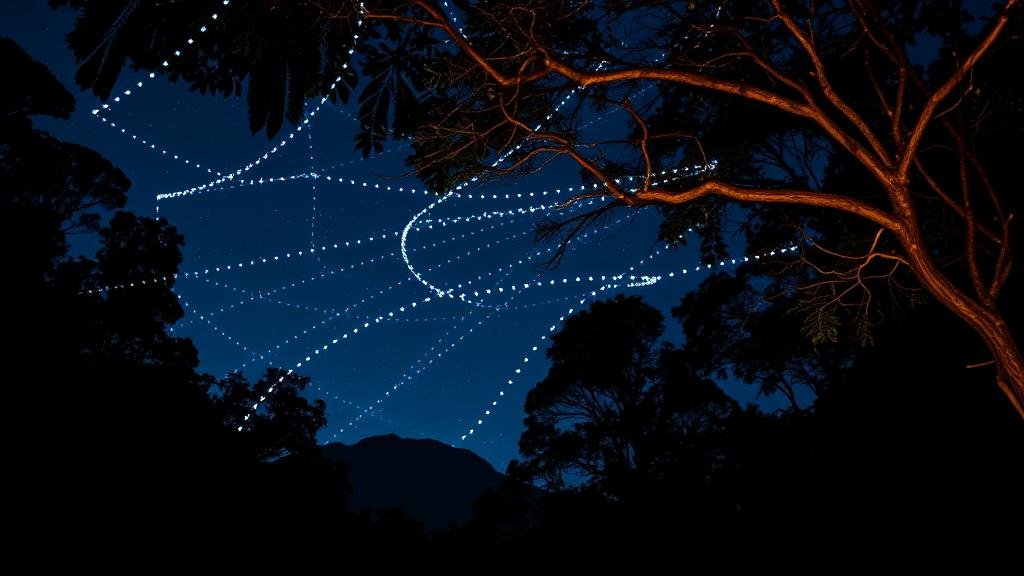Documenting the nocturnal dance of fireflies in remote tropical forests.
Documenting the Nocturnal Dance of Fireflies in Remote Tropical Forests
Fireflies, known for their enchanting bioluminescent displays, offer a captivating spectacle in the remote tropical forests of the world. Their intricate mating rituals and vibrant light patterns serve not only as a form of communication but also as a unique topic for scientific study. This article aims to explore the significance, challenges, and methodologies involved in documenting the nocturnal dance of fireflies in these enchanting ecosystems.
The Significance of Fireflies
Fireflies, or lightning bugs, belong to the family Lampyridae and are widely distributed across the globe, with a particular abundance in tropical regions. r bioluminescence, a fascinating natural phenomenon, occurs due to a chemical reaction involving luciferin and luciferase, resulting in light being emitted without heat–a process termed cold light. Fireflies play a vital role in their ecosystems, acting as pollinators and serving as food sources for various predators.
Historical Context
The study of fireflies dates back centuries, with notable contributions from scientists such as Charles Darwin and Thomas Edison, who utilized their bioluminescence to gain insights into ecological and evolutionary concepts. In the early 2000s, researchers began to investigate firefly populations more rigorously, prompted by declining numbers in various regions due to habitat loss, light pollution, and climate change.
Remote Tropical Forests as Habitats
Remote tropical forests, such as those found in the Amazon Basin, Southeast Asia, and Central Africa, provide ideal habitats for fireflies due to their rich biodiversity and minimal disturbance from human activity. The dense foliage, high humidity, and warm temperatures create a perfect environment for these insects to thrive.
Key Locations for Study
- The Amazon Rainforest, Brazil: Spanning over 5.5 million square kilometers, it hosts a large variety of firefly species.
- Borneo Rainforest, Malaysia: Known for its incredible biodiversity, Borneo is home to unique firefly species like the Pteroptyx genus.
- The Congo Basin, Democratic Republic of the Congo: With its complex ecosystems, it presents an opportunity to study lesser-known firefly behaviors.
Challenges in Documenting Fireflies
Despite their allure, documenting fireflies in remote tropical forests involves significant challenges. Researchers face obstacles such as poor access to study sites, the necessity of specialized equipment, and variability in environmental conditions.
Environmental Concerns
Climate change poses a substantial threat to firefly populations. Studies have shown that temperature rises can disrupt firefly mating habits, which rely heavily on synchronized flashing. Also, habitat destruction due to logging and agriculture continues to endanger these delicate ecosystems.
Technological Limitations
Field researchers often rely on night-vision cameras, which can be expensive and difficult to manage in remote locations. Innovative techniques, like using light traps or drones equipped with cameras, explored, but these methods require thorough testing to ensure accuracy and reliability.
Methodologies for Documentation
The study of fireflies involves several methodologies aimed at observing their behaviors and understanding their ecological roles. Collaborative efforts between entomologists, ecologists, and conservationists are crucial for successful documentation.
Field Observations
- Night Surveys: Researchers conduct nocturnal surveys to record firefly activity patterns and assess species diversity.
- Behavioral Analysis: Gaining insights into mating rituals by observing flashing patterns and interactions among individuals.
Data Collection and Analysis
Utilizing software tools and statistical models, researchers analyze large datasets gathered from field observations. This data can help establish correlations between environmental conditions and firefly behaviors, crucial for conservation efforts.
Real-World Applications and Conservation Efforts
Understanding firefly patterns and behaviors not only contributes to entomological science but also promotes conservation goals. By mapping firefly habitats and analyzing population dynamics, researchers can advocate for biodiversity preservation and habitat restoration efforts.
Community Engagement
Raising awareness about the importance of fireflies can engage local communities in conservation initiatives. Educational programs that emphasize the ecological significance of fireflies can help foster a sense of stewardship and protect these vital habitats.
Actionable Takeaways
- Engage in citizen science by participating in local firefly observation events to support conservation initiatives.
- Advocate for reduced light pollution in urban areas to promote healthier firefly populations.
- Support conservation organizations focused on preserving tropical forests and their unique biodiversity.
By documenting the nocturnal dance of fireflies in remote tropical forests, researchers not only uncover the mysteries of these remarkable insects but also emphasize the importance of protecting the delicate ecosystems they inhabit.



